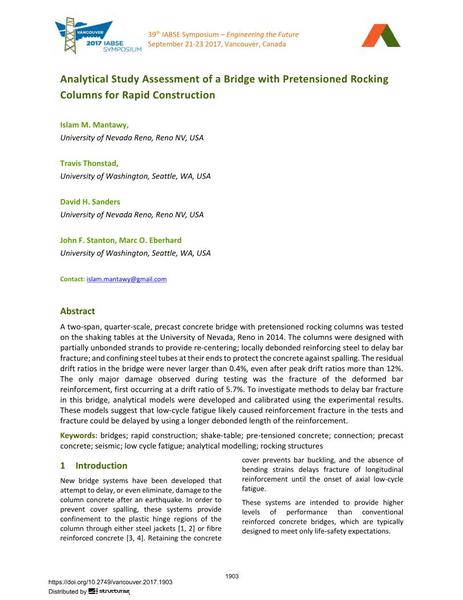Analytical Study Assessment of a Bridge with Pretensioned Rocking Columns for Rapid Construction

|
|
|||||||||||
Détails bibliographiques
| Auteur(s): |
Islam M. Mantawy
(University of Nevada Reno, Reno NV, USA)
Travis Thonstad (University of Washington, Seattle, WA, USA) David H. Sanders (University of Nevada Reno, Reno NV, USA) John F. Stanton (University of Washington, Seattle, WA, USA) Marc O. Eberhard (University of Washington, Seattle, WA, USA) |
||||
|---|---|---|---|---|---|
| Médium: | papier de conférence | ||||
| Langue(s): | anglais | ||||
| Conférence: | IABSE Symposium: Engineering the Future, Vancouver, Canada, 21-23 September 2017 | ||||
| Publié dans: | IABSE Symposium Vancouver 2017 | ||||
|
|||||
| Page(s): | 1903-1910 | ||||
| Nombre total de pages (du PDF): | 8 | ||||
| Année: | 2017 | ||||
| DOI: | 10.2749/vancouver.2017.1903 | ||||
| Abstrait: |
A two-span, quarter-scale, precast concrete bridge with pretensioned rocking columns was tested on the shaking tables at the University of Nevada, Reno in 2014. The columns were designed with partially unbonded strands to provide re-centering; locally debonded reinforcing steel to delay bar fracture; and confining steel tubes at their ends to protect the concrete against spalling. The residual drift ratios in the bridge were never larger than 0.4%, even after peak drift ratios more than 12%. The only major damage observed during testing was the fracture of the deformed bar reinforcement, first occurring at a drift ratio of 5.7%. To investigate methods to delay bar fracture in this bridge, analytical models were developed and calibrated using the experimental results. These models suggest that low-cycle fatigue likely caused reinforcement fracture in the tests and fracture could be delayed by using a longer debonded length of the reinforcement. |
||||
| Mots-clé: |
ponts
|
||||
